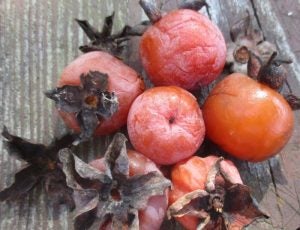Persimmon trees are a sweet Virginia native
Published 10:19 am Wednesday, November 7, 2018
It’s that time of year again when the geese are on the wing and we turn our thoughts to the splendor and abundance of fall. The fields along Western Tidewater’s roads are full of cotton and soybeans ready to be harvested and the roadsides are gleaming with bright yellow wild flowers of all descriptions … a feast for the eyes. The trees are preparing for their show of color, but it is just a bit too early for most. One of my favorite trees to see is the persimmon tree (Diospyros Virginiana) a feast for the eyes and for wildlife.

Ripe persimmons are nature’s candy for both people and wildlife. — Submitted | Susan and Biff Andrews
As we walk through the woods this time of year, I have two persimmon trees that are like old friends I look forward to seeing. They are small trees that blend in with the rest of the small trees. Their leaves are leathery and can be yellow or a reddish purple color this time of year. Although the leaves are different, the trees are about the same size and shape as dogwoods and are hard to spot before they start to show off their fruit. Of course the dogwood fruit is bright red.
On the persimmon tree the leaves are not about the show as much as the beautiful fruit, The fruit is a small globe-shape, a little smaller than a golf ball. They are a pale purple color when ripe. They glisten in the top of the trees like little ornaments. Some yellow-green (unripe) some yellow-orange (getting ripe) and the reddish-orange to light purple ones that are ripe and ready to fall to the ground.
The persimmon tree is in the Ebony family (Ebenaccease.) The wood is very hard, smooth and even textured which makes it shock-resistant. This is why it is used to make driver heads for golf clubs. It is also used in the textile industry for making shuttles and bobbins. But let’s get back to the fruit, one of mother nature’s trick or treat surprises. It is like candy when it is ripe. When it is ripe is the big disclaimer.
So how do we know when it is ripe? Well, there’s the hard way and the easy way. If you taste one that is not ripe it will give you such a pucker your mouth might turn inside out … that’s the trick. The best thing to do is let them get ripe and fall to the ground then it’s as easy as collecting candy from the neighbors … that’s the treat.
Speaking of the neighbors, this tree is also like candy for wildlife. Bees make honey from the flowers and the fruit is eaten by just about all God’s creatures. White-tailed deer enjoy the fruit in the fall and the twigs in winter. Skunks, squirrels, fox, bear, coyote, raccoons, opossums, wild turkey, quail,and many other birds love this fruit. Persimmons are good for humans as well, they’re very nutritious and contain more potassium than bananas.
Persimmons can be eaten just as they are or can be used to make cakes, custards, puddings, cookies or sherbet. But when you are collecting them watch out for the ABC’s (already been chewed;) leave them for the critters. As always with any wild food, be sure it is what you think it is before you eat it. Double-check your field guide carefully before consuming anything from nature and read up on recipes, preparation and handling before you start.
Bon appetit!
SUSAN and BRADFORD “BIFF” ANDREWS are retired teachers and master naturalists who have been outdoor people all their lives, exploring and enjoying the woods, swamps, rivers and beaches throughout the region for many years. Email them at b.andrews22@live.com.





